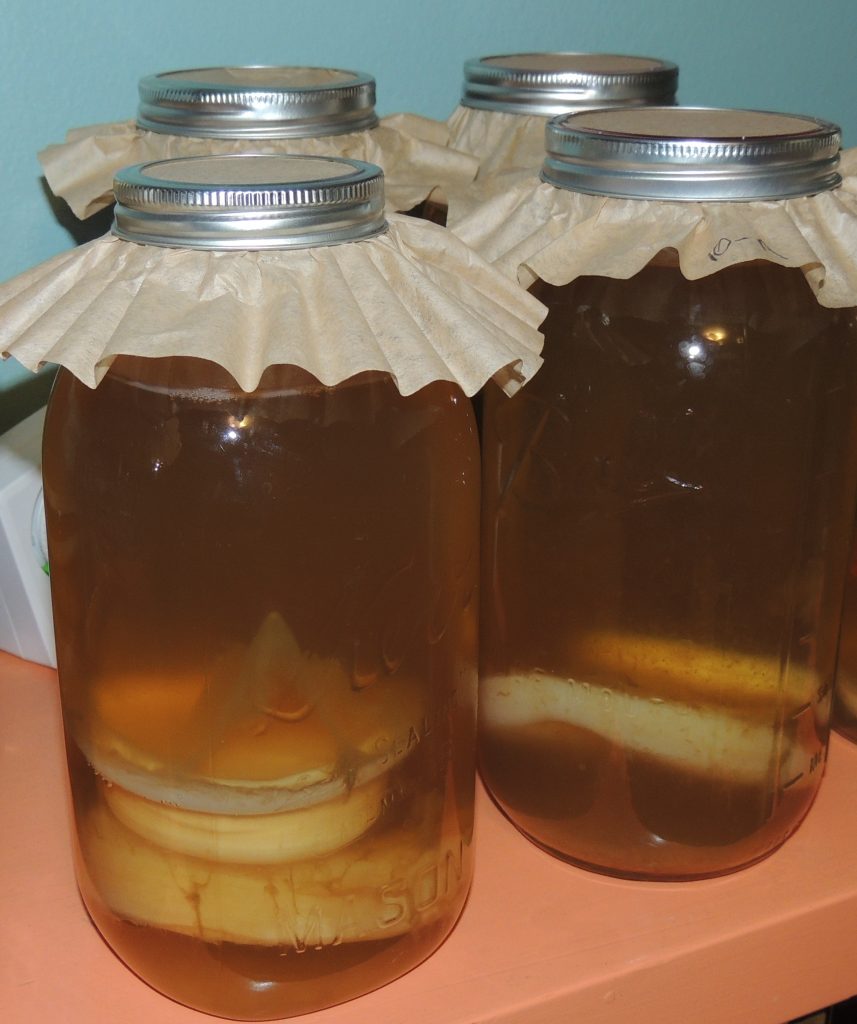What is kombucha?
Kombucha is a lightly effervescent, cider-like beverage, made by fermenting sweetened tea. It is produced using a starter culture of bacteria and yeasts called a SCOBY (Symbiotic Colony of Bacteria and Yeast). A mature SCOBY resembles a flat, jelly-like pancake, often referred to as a ‘mushroom’ or ‘tea fungus’ due its unique appearance, although it is not a mushroom.

Nutrition and health benefits
Kombucha contains live beneficial bacteria and yeasts, organic acids, B vitamins, antioxidants, and trace minerals. Added juice or flavorings may contribute nutrients as well. With only about 30 calories and 2-3 grams of sugar per 8 ounces of unflavored kombucha, kombucha can be a refreshing, low calorie beverage.
Health impacts attributed to kombucha vary widely, from claims of multiple therapeutic effects, such as improved digestion, gut health, and immune function, to adverse reactions if acid levels become unusually high. Only limited scientific research is available to help answer questions about the benefits and safety of kombucha.
How is kombucha made?
Maintain safe and hygienic practices, such as following proper steps and keeping a clean environment, to minimize risk of contaminants such as molds or harmful bacteria which could cause illness. Always wash hands well and rinse with kombucha or vinegar before handling the SCOBY. First, obtain a SCOBY and starter liquid, either from a friend’s mature starter or purchased fresh online. The SCOBY and liquid are added to a food-grade vessel of brewed, cooled, sugar-sweetened tea, then lightly covered and allowed to ferment at room temperature, typically for 7-10 days but possibly up to one month. The liquid acidifies the tea to assure a safe pH level and minimize contamination, while the sugar feeds the bacteria and yeast, producing an acidic end product which tastes a bit like cider vinegar, typically with slight carbonation and trace amounts of alcohol. Fruit juice or other flavorings may then be added as desired.
Precautions
When consuming any new food or beverage, start small (up to 4 ounces per day with plenty of water) and observe your own body’s results. Under some conditions, the alcohol level may exceed 0.5 percent alcohol by volume, which surpasses the limit for non-alcoholic beverages. If any signs of spoilage are noted, such as fuzzy blue, gray, green, brown, or black mold, discard the SCOBY and kombucha, and thoroughly wash vessel.
Ingredients for 1 gallon:
- 1/4 cup green and/or black tea (in mesh bag), or 4-8 tea bags
- 1 gallon of filtered water
- 1 cup cane sugar
- 1-2 cups Kombucha Starter Liquid (from a previous batch)
- 1 SCOBY
Equipment:
- Tea kettle or pot, for heating water
- Brewing vessel, safe for fermenting (i.e. large glass jar, stainless steel, food grade plastic)
- Clean fine weave cloth, towel, or coffee filter (large enough to cover brew vessel)
- Rubber band (wide enough to fit around brew vessel)
- Bottles or jars, for finished kombucha
- Funnel (optional)
Instructions:
- Heat water. In brewing vessel, make tea. Steep tea for 10 minutes.
- Remove tea leaves or bags. While water is still hot, stir in sugar and completely dissolve.
- Allow sweetened tea to completely cool to room temperature. **
** Alternative method to cool faster: Heat only half the water in step #1, to make a strong sweet tea, then add the remaining water as cold water. - Once cooled to room temperature, with washed hands, add SCOBY and Kombucha Starter Liquid to sweetened tea.
- Cover with clean cloth or coffee filter. Secure with a rubber band or bungee cord to keep insects and contaminants out but allow air flow. Record start date.
- Allow kombucha to ferment at room temperature (ideally 64-79°F/18-26°C) for 7-14 days. A new SCOBY will develop on the surface of the liquid, starting as a light haze that gradually turns whitish, then opaque and thicker as time progresses. Check the kombucha flavor after a week. Stop fermenting when you like the flavor.
- To “stop” fermenting: pour kombucha into clean jars or bottles sanitized by rinsing with boiling water or vinegar, retaining SCOBY and at least 1-2 cups for your next batch. Save more, at least 20%, if following continuous brew technique (see below).
- Flavor finished kombucha as desired with 10-20% juice or clean fruit, and experiment with clean herbs and spices based on preference. Cap tightly. Leave at room temperature 1-3 days for potential carbonation or refrigerate immediately. CAUTION: Longer time capped at room temperature could result in carbon dioxide accumulation and even explosion of the contents.
Repeat batches using continuous brew technique:
To minimize handling the SCOBY and reduce introduction of contaminants, it is better to leave the SCOBY and starter liquid in the vessel and not wash the vessel between uses, but only if it becomes built up with yeast. Gently pour in new sweetened, cooled tea along the inside of the jar to limit disturbing the SCOBY. SCOBY growth can be peeled and shared with others or stored for several weeks in a similar cloth covered vessel, covered by kombucha.
- For safety, both homemade and commercially prepared kombucha should be stored refrigerated.
- Historical origins of kombucha date back thousands of years to ancient Asia.
Kombucha Resource
Kombucha brewing under the food and drug administration model food code: Risk analysis and processing guidance. Nummer(2013). J Environ Health 76(4):8-11.


